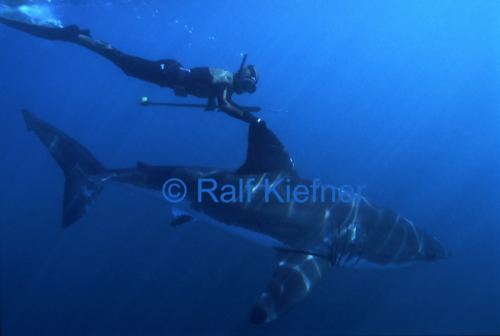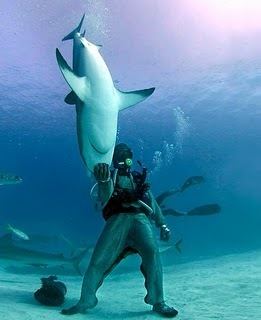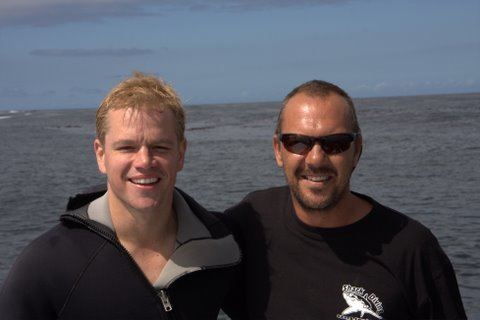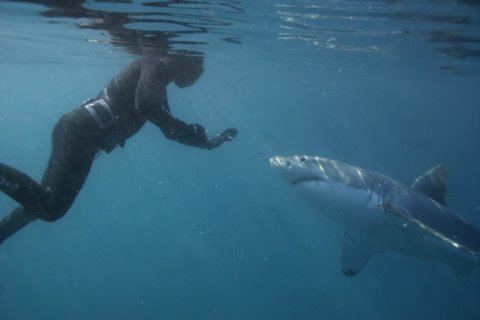Name Mike Rutzen | ||
The great white extended interview with mike rutzen
Michael Rutzen (born October 11, 1970) is a South African conservationist, film maker, cage diving operator. He has spent more time free diving with great white sharks without a cage than any other person and is one of the few people in the world that can understand and respond to shark behaviour and body language.
Contents
- The great white extended interview with mike rutzen
- Sharks mike rutzen
- Early life
- 19932013 Career beginnings and breakthrough
- 2005Present International success
- Present
- In The Media
- Personal life
- Achievements
- References

Mike started his career as a fisherman before joining the shark diving industry in 1994 establishing the pioneering techniques that are now the backbone of the industry. In 2000 he founded a successful shark cage diving business, Shark Diving Unlimited. Driven to better understand white shark’s behaviour he found that observing them from a vessel was limiting so in 1998, he began free diving with white sharks.

Rutzen gained international fame by appearing in a number of award winning documentaries which promote appreciation and conservation of sharks to the general public. These films and a number of TV appearances led to him being known as the "Sharkman". Mike is highly sought as a shark guide by world-renowned still photographers, film crews, celebrities and royalty and has hosted a number of very high profile guests on shark observation and diving trips including Brad Pitt, Matt Damon, Leonardo DiCaprio, Halle Berry, King Abdullah II Of Jordan, Blake Lively, Sheik Nahayan Mabarak al Nahayan,Sheikh Mohammed bin Hamad bin Khalifa Al Thani, One Republic and Prince Harry.

Since the very beginning of his career as conservationist, Michael has provided field support to the Department of Environmental Affairs of South Africa, when they require his shark expertise. Some projects include deployment of satellite and acoustic tags on white sharks and he is also a member of the Whale Disentanglement Network for the Department of Environmental Affairs. Since 2009 he has acted as field supervisor for population dynamics studies and DNA sampling programs being undertaken for the PhD study of Dr. Sara Andreotti (Stellenbosch University), which he also sponsored and co authored a number of white shark behavioural papers.

He is one of the inventors of the eco friendly Shark Safe Barrier, which prevents negative encounters between sharks and people. He is currently preparing the barrier for final testing and deployment for the protection of both sharks and man.

Sharks mike rutzen
Early life

Rutzen was born in Johannesburg, South Africa, the youngest of 5 children. He is the son of Richard Harvey Rutzen, an Evangelist in the New Apostolic Church, of Austrian descent and Marie Rutzen (nee Stydom),of Afrikaans descent. He has two older sisters and two older brothers, one of whom is 20 years older than Mike. Due to lung complications from his premature birth, Mike’s father moved the family from the city to the small farming town of Brits in The Northern Transvaal when Mike was aged 5 so he and his older brother could benefit from the fresh country air. As the youngest in his family by many years, Mike spent a lot of his childhood alone, exploring the natural bush and the granite hills of the region surrounding the farm. There he learned important skills in bush survival and the understanding of animal behaviour, in particular of snakes, baboons and leopards. By the age of 7 he started going to sea on his aunt’s boat, in Tugela River Mouth where he learned to fish and developed a deep love for the ocean.
1993–2013: Career beginnings and breakthrough
After high school Rutzen enlisted in the South African Defence Force (SADF) as a medic in the 115 Battalion. He spent 2 years in the bush where he further honed his survival skills. At the age of 20 he visited the quaint fishing village of Gansbaai in the Western Cape, he liked it so much that he decided to stay and make a life there as a commercial fisherman. In 1993 the shark cage diving industry was established in Gansbaai and Mike was the second local skipper to be employed for his specialised seafaring expertise in the region. He spent a lot of time interacting with Great White Sharks from the boat and observing their behaviour during this time.
Mike developed a huge appreciation for these majestic, apex predators. He decided he would like to learn more about the species, so in 1998 he began free diving with the sharks. In 2000 he established his own his highly successful shark cage diving company, Shark Diving Unlimited.
While in the water with the sharks Mike was extremely cautious and used his knowledge of animal behaviour to understand the shark’s movements and to interact with them. From this expertise he was able to communicate with the sharks by making his body smaller or larger to attract or deter the animal.
2005–Present: International success
Mike’s underwater shark interactions attracted the attention of the media and his first documentary, National Geographic’s Beyond Fear was released in (2005) which described shark behaviour and body language and showed Mike free diving with Great Whites without a cage. The film was shown internationally on National Geographic Channel and was viewed by more than 300 million people.
This documentary was soon followed 2006 by "Sharks Man-Eaters or Misunderstood? A John McIntyre Production in association with PADI, Sport Diver and Shark Diving Unlimited to educate workers at Blue Planet Aquarium.
As he observed the sharks further, Mike noted that there was a lot more to them and they "were not the mindless killing machines out to hunt us" as portrayed in horror films. He decided to pursue more knowledge of these predators and contacted the world’s leading shark experts.
In 2007 Mike’s Discovery documentary "Sharkman" went to air. Mike had developed the storyline by visiting the world’s best shark experts in their fields and learning their expertise from them. He learned one form of tonic immobility from Dr. Samuel Gruber and another form of Tonic Immobility from Christina Zenato, a behaviour which would lead him to the initial idea for the Sharksafe Barrier later on.
Sharkman was a huge hit and became the Discovery Channel’s Shark Week staple for over ten years. In 2009, Mike was featured as the "Sharkman" on 60 Minutes with Anderson Cooper CBS Mike then joined with BBC Natural world to develop The Great White Shark, A Living Legend from 2008-2009 in which Mike visited a popular seal hunting area to better understand White Sharks and then 2010: Shark Night on (Discovery French TV)
Mike was featured as a shark expert in the IMAX 3D Film, Great White Shark 3D (2010) which was filmed in his hometown of Gansbaai and used stunning underwater and aerial footage. The film was screened in IMAX theatres internationally.
Later that year Mike acted as stunt double and shark behaviour expert for Halle Berry’s character in the 2010 Warner Brothers film Dark Tide which was filmed in Gansbaai and based loosely on Rutzen’s life experiences.
2010 also saw Mike featured as the ‘Sharkmaster' on Stan Lee’s Superhumans
Present
Since 2009, Rutzen has continued his conservation work by providing field support to the Department of Environmental Affairs of South Africa (deployment of satellite or acoustic tags on white sharks and the diver for the acoustic tagging programme) and other research projects that require his expertise. He is also a member of the South African Whale Disentanglement Network of South Africa, group of marine experts who assist whales in distress.
He has also acted as field supervisor for white shark population dynamics studies and DNA sampling programs undertaken for the University of Stellenbosch for the PhD study of Dr. Sara Andreotti, which he also sponsored. He and Andreotti spent up to four years collecting, photographing and sampling shark genetic data in the most extensive field research project ever conducted on White Shark DNA around the South African coastline
The groundbreaking study identified that South African white shark’s long term survival is under jeopardy with an extremely low genetic diversity. 89% of South African White Sharks share exactly the same lineage and have the lowest diversity for white sharks in the world. This could jeopardise the future survival of the species, and lead to possible extinction.
The study, also concluded that the South African white shark belong to one population, with the same sharks sampled in the east coast (Algoa Bay) also being identified in the South West Coast (False Bay) an implication that is very important in terms of population management.
As part of this research he co authored a number of white shark scientific behavioural papers.
Rutzen is one of the inventors of the eco friendly Shark Safe Barrier, which prevents negative encounters between sharks and people. The barrier was conceived in 2011 when Mike met Dr. Craig O’ Connell, a marine biologist. Mike had noticed that sharks did not swim through the local kelp forests, even when pursuing cape fur seals. This inspired the idea for a visual barrier resembling kelp to have the potential to became the first eco-friendly alternative to the shark nets. Craig was working on his PhD project exploring the use of electrosensory stimuli, such as permanent magnets to repel sharks, with much success. The two joined forces and combined their knowledge.
The Sharksafe Barrier is made of four rows of large vertical pipes fitted with magnets that move with the ocean currents and tides to manipulate the swim patterns of sharks. These magnets overstimulate the unique electrosensory system of Elasmobranchs (i.e. sharks, skates, and rays), known as the Ampullae of Lorenzini which detect the electromagnetic fields. These are associated with prey and may also be capable of detecting geomagnetic fields (0.25-0.65 Gauss) to orientate the sharks during long migrations. This makes the Sharksafe Barrier shark-specific so other marine animals can swim through it without issue.
The Sharksafe Barrier is currently undergoing final scientific and engineering testing ahead of its first beach deployment.
In The Media
Rutzen's performances in a number of documentaries prompted the media to call him "The Sharkman" first stated by Anderson Cooper in his appearance on 60 Minutes America Stan Lee of Superhuman’s Fame called him the "Sharkmaster" for his ability to swim with Great White Sharks without a cage and understand their body language.
Personal life
Rutzen currently resides between his houses in Gansbaai, South Africa and Tofino Beach in Mozambique with his partner, brother and two Mozambican beach dogs.
Achievements
Rutzen won a Lifetime achievement award at the Tourfilm Festival Prague (2012) for his contribution to extending human boundaries with respect to the world ́s oceans and in particular for his pioneering work with sharks.The festival organisers stated "It is our humble opinion that your work is reducing man ́s innate fear of the marine environment". He was also awarded Princeton Global Network Registry Member of the Year (2012), was awarded the Mare Nordest – Adriatico! Un mare d’idee e non solo, Trieste (2012) and the Mayoral's Award for Conservation - Overstrand District South Africa (2015).
